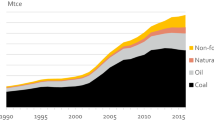Abstract
It is suggested in the proposal of the 11th Five Year Plan (from 2006 to 2010) that the total reduction rate of energy intensity per GDP (2005–2010) should be 20%. The annual reduction rate of energy intensity between 2005 and 2010 must reach 4.3% to meet this goal, and the elasticity of energy consumption should be less than 0.5. However, given that in 2000–2005 the average elasticity of energy consumption was as high as 1.084, it will be a great challenge to achieve the goal. We characterize the progress on energy efficiency in the context of the overall Chinese energy system, including both government policies and business efforts. When reviewing recent progress made (until 2007), major energy efficiency improvements can be observed. China is now adopting best efficiency practice in its newly installed capacity. This paper presents the policy packages and efficiency achievements in industry and other sectors.



Similar content being viewed by others
References
Energy Office (2006). Study on international comparison on energy efficiency, research report.
Fei, F. (2007). China’s policy and strategy to realize 11th Five Year Plan energy target. Beijing: China Science Press.
Jiang, K. (2007a). China greenhouse gas emission scenario research, in international climate change regime: a study on key issues in China. Beijing: China Environmental Science Press.
Jiang, K. (2007b). Energy Technology Innovation, in Innovation with Chinese Characteristics. In High-tech Research in China. New York: Palgrave.
Jiang, K., & Xiulian, H. (2006). Energy demand and emission in 2030 in China: scenarios and policy options. Environment Economics and Policy Studies, 7(3), 233–250.
Jiang, K., & Xiulian, H., (2007). China’s new climate change strategy: domestic policies and international politics, ICTSD publication, 2007.
Jiang, K., Xiulian, H., Liu, Q., Zhuang, X., & Liu, H. (2007). Allocation of the energy intensity target into sectors, in Feng Fei, China’s policy and strategy to realize 11th Five Year Plan energy target. Beijing: China Science Press.
Jiang, K., Xiulian, H., Zhuang, X., Liu, Q., & Zhu, S. (2008). China’s energy demand and emission scenarios by 2050. Climate Change Research Review, 4(5), 296–302.
Jiang, K., Xiulian, H., Liu, Q., Zhuang, X., & Liu, H. (2009). China’s low carbon economy scenario, in low carbon economy development in China. Beijing: China Science Publishing House.
Li, J. (2007). Renewable energy development in China, in Han Wenke, China energy issues research. Beijing: China Planning Publishing House.
NDRC (2004). Medium and long term Energy Conservation Plan.
NDRC (2007a). Synthesis working plan on energy conservation and emission reduction.
NDRC (2007b). Renewable energy long- and medium-term development plan.
NSB (2007a). China statistic yearbook 2007. Beijing: China Statistic Publishing House.
NSB (2007b). China energy statistic yearbook 2007. Beijing: China Statistic Publishing House.
State Council (2006) Outlines of national economic and social development program for the 11th Five-Year Plan.
Author information
Authors and Affiliations
Corresponding author
Rights and permissions
About this article
Cite this article
Kejun, J. Energy efficiency improvement in China: a significant progress for the 11th Five Year Plan. Energy Efficiency 2, 401–409 (2009). https://doi.org/10.1007/s12053-009-9054-x
Received:
Accepted:
Published:
Issue Date:
DOI: https://doi.org/10.1007/s12053-009-9054-x




